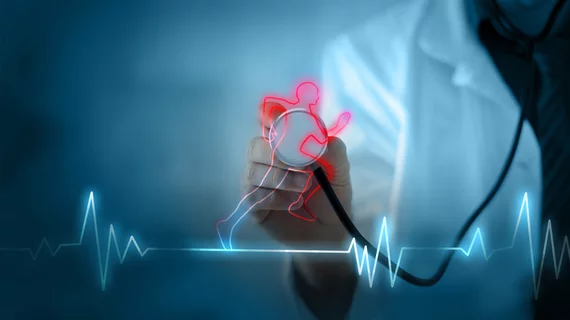ORBITA researchers show physiological benefit of PCI for stable CAD
The same investigators who ignited debate among interventional cardiologists with the ORBITA trial in November 2017 have now published a small study highlighting the ability of percutaneous coronary intervention (PCI) to immediately reduce ischemia and boost patients’ exercise capacity.
Taken together, the two studies suggest both physiological and placebo effects may factor into the therapeutic benefit of PCI, wrote Christopher M. Cook, MBBS, and colleagues in the Journal of the American College of Cardiology.
The researchers recruited 21 patients with stable coronary artery disease (CAD) from elective PCI waiting lists. All patients had single-vessel disease, were on maximally tolerated antianginal medication and had hemodynamically significant stenosis in the target vessel, defined as fractional flow reserve (FFR) of 0.80 or less or instantaneous wave-free ration (iFR) of 0.89 or lower.
Immediately following PCI, the patients achieved an average improvement of 67 seconds during a standardized exercise test, as well as an 81 percent reduction in rate-limiting angina symptoms. Put another way, 95 percent of the patients who underwent the exercise test before PCI stopped because of chest pain or breathlessness, while all but 10 percent in the post-PCI test stopped because of exhaustion—not angina symptoms.
“This study shows that coronary flow and pressure cannot rise to meet the demands of physical exercise when there is a significant coronary stenosis,” Cook et al. wrote. “PCI immediately normalizes the ability of coronary flow and pressure to rise to match this myocardial demand.”
In the randomized, double-blind ORBITA trial, results suggested PCI was associated with a modest improvement in exercise capacity that wasn’t significantly longer than the improvement seen with a sham procedure.
But in the new study, hemodynamic measurements showed a clear and immediate benefit of revascularization. The following indicators of ischemia showed improvement from pre- to post-PCI: FFR (0.59 to 0.91), iFR (0.61 to 0.96) and coronary flow reserve (1.7 to 3.1).
“The measured objective findings demonstrate that for truly ischemic lesions, PCI works, relieving ischemia and angina, and likely works much better than medical therapy,” wrote Morton J. Kern, MD, and Arnold H. Seto, MD, MPA, both with the Veterans Administration Long Beach Health Care System in California, in a related editorial.
“Although this study will not make the front page of the New York Times, it should go a long way to restoring confidence in the physiological basis for PCI and supporting its continued use for patients with stable angina.”
Cook et al. said the traditional advice of waiting to ramp up physical exercise following PCI might not be necessary. The patients in this trial tolerated exercise without complications immediately following the procedure.
The researchers chose a “highly selected” group of patients—those with single-vessel disease and significant stenosis—in whom a complete resolution by stenting was likely. They said it is unknown how patients with multivessel disease or those who received multiple stents would progress after PCI.
Nonetheless, the authors believe there are lessons to be taken away from both this trial and ORBITA. The physiological data is compelling, but a placebo effect may be profound as well. After all, the patients in the JACC study knew they were receiving stents—they couldn’t be sedated because of the exercise requirements—and may have performed better on exercise testing as a result of that psychological boost. The same could hold true in everyday practice, the authors pointed out.
“As clinicians, we should feel confident about the biological plausibility of PCI as an effective therapy for the relief of angina; however, we should also be aware that patients also gain some functional improvement from placebo,” Cook and colleagues wrote. “Therefore, we should take the opportunity of the PCI procedure to emphasize to the patient how effective the PCI has been, both anatomically and physiologically. … We speculate that in addition to enhancing overall patient education, simple steps such as these would maximize the overall therapeutic benefit of PCI in stable angina.”

